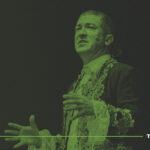More institutions, less nostalgia.
That’s the prescription for American civil society in Yuval Levin’s recent (and excellent) The Fractured Republic: Renewing America’s Social Contract in the Age of Individualism [interview]. Levin has unapologetically written a book about politics, and both his diagnosis of the current problem and also his proposals for the solution are politically, economically, and culturally framed.
But as I was reading it, something occurred to me: his argument applies with uncanny accuracy to many evangelical and particularly charismatic churches, including my own.
Best of Both Worlds
Levin’s argument is that much contemporary political discourse is characterized by nostalgia for the 1950s and 1960s. For the Left, it’s a longing to return to the economic solidarity of the post-War years (low inequality, worker benefits, strong unions) alongside its cultural liberalization (sexual revolution, civil rights)—despite the free-market nuts who are destroying the nation. For the Right, it’s a longing to return to the cultural solidarity of the post-war years (strong families, churches, social responsibility) alongside economic growth (strong corporations, job creation, increasing prosperity and living standards)—despite the liberalizing socialists who are destroying the nation. Levin cites numerous examples—from both Left and Right, from Obama to Trump—of politicians and thought leaders appealing to precisely this narrative.
Yet the problem is this narrative omits a crucial feature of those two decades: they represent an exceptional moment in American history, in which a society of solidarity and cohesion rapidly became liberalized, diversified, and individualized. The historical moment was unrepeatable: Huge solidarity had emerged in the wake of the Great Depression and the Second World War, the population was booming, and America—as the only developed economy not decimated by the war—became dominant.
After the war, in response to the cultural conformity and homogeneity that characterized American society, a rapid process of liberalization took place both culturally and economically—from civil rights to the sexual revolution, from increased consumer choice to a larger state. The effects of this rapid process remain with us today. But because its positives were felt straight away and the negatives didn’t kick in immediately, the 1950s and 1960s uniquely represented the best of both worlds. The benefits of cohesion and solidarity were still in place, even as the diversification and liberalization of society produced new opportunities. It wasn’t until the 1970s that the negative effect of this process of individualization—fragmentation, fierce political division, the diminution of the family, economic stagnation, institutional decline, social fracture—began to kick in.
So today, to repair this fracture, we face a dire need to reinvest in the “middle” institutions that sit between individuals and the state—charities, unions, clubs, churches, companies, and the like.
I think the same thing is true of the church.
Good Ol’ Days

I’ve been in charismatic churches for most of my life, and our controlling narrative goes something like this.
There were a lot of strengths to established denominations in the 1950s and 1960s, but they were quite stuffy: bookish, repetitive, conformist, cautious, and a bit dull. Then, when the charismatic movement began, new waves of freedom began crashing across the church, and we started singing like we meant it, lifting our hands, dancing, speaking in other languages, prophesying, taking the gospel to the streets, praying for healing, and living as if Jesus is alive rather than dead. But the established denominations didn’t like it, so they either kicked us out, or we left to form our own communities. The separation, sad as it was, gave us a new lease on life. We remained passionate about prayer, discipleship, good theology, and cultural engagement, but we grew in passion, experience, creativity, and zeal. We replaced dusty denominational committees with groups of leaders who shared a passion. It was wonderful.
It’s not quite the same these days, though. The movement has fragmented. Some charismatic groups became flaky and liberal, ditched the gospel, ditched the church, and went weird. Others have gradually morphed back into the kinds of churches we left. Although they still believe the gifts are for today, they’ve reintroduced formalism and gone all traditional in a variety of ways. Many of us are still true believers, of course, but the sense of togetherness, the pioneering spirit, and the fusion of passion and community across the whole movement aren’t what they were. We need to recapture—or, if we’re more optimistic, retain—the good ol’ days.
Spooky Parallels
The parallels between that narrative and the ones Levin critiques are striking, even spooky. The reason is simple: Highly cohesive and stable groups don’t disintegrate overnight. If you individualize, liberalize, and diversify a community previously characterized by solidarity, for a while you can live with the best of both worlds: the togetherness of the old order and the freedom of the new one. But as time goes on, that freedom leads people to prioritize their own choices over the group’s, and solidarity diminishes. It may take 20 years, but it happens eventually.
So by decrying denominations and replacing them with networks (which are, let’s be honest, denominations with cooler fonts), and by abolishing the institutions that make them strong, we rather dramatically reduced our ecclesial capital, if I can (rather pretentiously) call it that. Practically, this means we end up borrowing it from other denominations and churches. So, as charismatics today, our best songwriters are often either Anglican or Pentecostal. The commentaries in our offices are all written by Baptists or Presbyterians. When it comes to social issues, we let Roman Catholics do the heavy lifting. Our prayers are shaped by Methodists and Moravians. None of this is bad in itself, of course; learning from other traditions is wonderful. But without building liturgies and libraries and seminaries and institutions of our own—a process that takes decades—we risk becoming derivative, disengaged, even irrelevant.
Having said all that, I’m personally optimistic. When I’ve talked to friends about this needed change, I’ve found all sorts of thoughtful charismatics around the world are already there, and many of them (Joshua Ryan Butler, Matt Anderson, Aaron Keyes, Glenn Packiam, Tony Reinke, Evan Wickham, and so on) are already writing songs, books, and doctoral theses of their own. Networks like Acts 29, the Vineyard, Sovereign Grace, and Newfrontiers are led by people who take theology and mission seriously. Next year, I get to speak at a conference on charismatic life with Sam Storms and Matt Chandler, and I don’t think you could accuse either of anemic nostalgia or anti-intellectualism. And it will certainly remain a passion of mine: the year after that I’m hoping to publish a book called Eucharismatic, in which I lay out what eucharistic and charismatic church, centred on charis, might look like.
But in the meantime, I think Yuval Levin’s prescription is spot-on, whether you’re charismatic or not. Less nostalgia, more institutions. Simple as that.
“The Most Practical and Engaging Book on Christian Living Apart from the Bible”
 “If you’re going to read just one book on Christian living and how the gospel can be applied in your life, let this be your book.”—Elisa dos Santos, Amazon reviewer.
“If you’re going to read just one book on Christian living and how the gospel can be applied in your life, let this be your book.”—Elisa dos Santos, Amazon reviewer.
In this book, seasoned church planter Jeff Vanderstelt argues that you need to become “gospel fluent”—to think about your life through the truth of the gospel and rehearse it to yourself and others.
We’re delighted to offer the Gospel Fluency: Speaking the Truths of Jesus into the Everyday Stuff of Life ebook (Crossway) to you for FREE today. Click this link to get instant access to a resource that will help you apply the gospel more confidently to every area of your life.


































